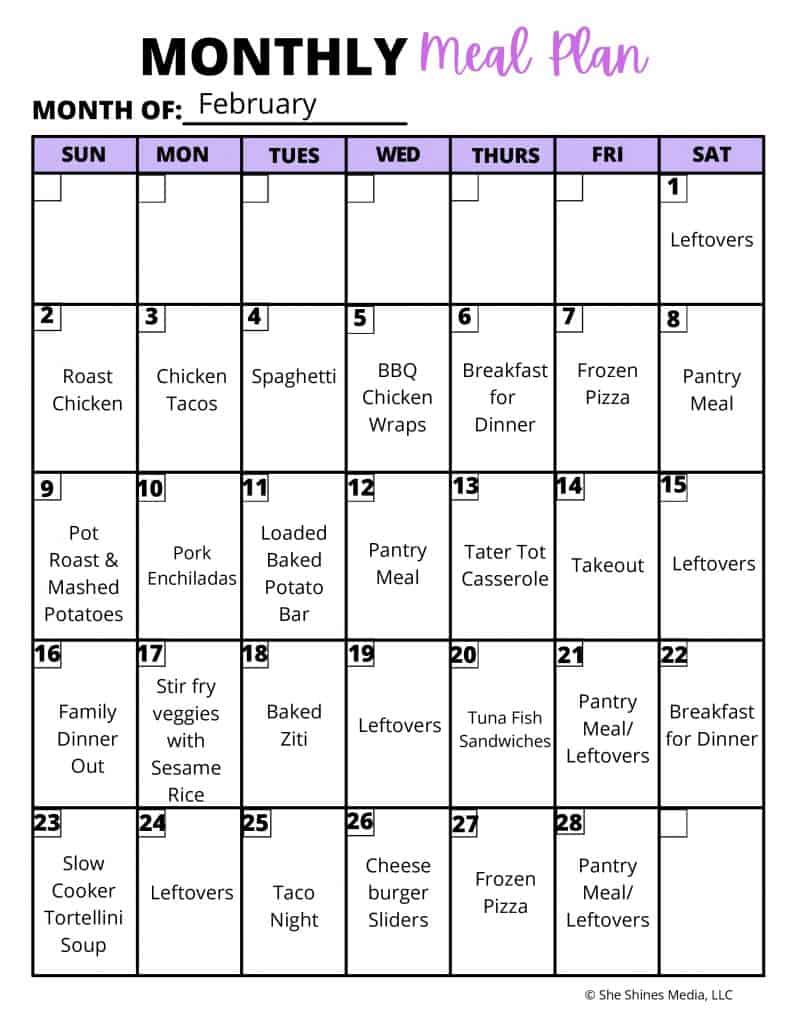How to Budget Meal Plan for Families {Free Printable}
Food expenses for families can be a HUGE struggle and add up fast, but budget meal planning and budget meal prep can help! Learn how to meal plan on a budget with these easy to use tools, and start saving hundreds of dollars every year on your grocery bill (and snag a free printable Monthly Meal Plan worksheet, too)!
When it comes to providing for our families, one of the biggest expense areas many of us face is around food. Grocery prices are soaring, and families all over the world find themselves struggling to continue to provide delicious and nutritious meals for their children.
When you have an entire family to cook for, it can be challenging to just “eat cheaper things,” because we all know how picky some kids can be. Our family swears by budget meal planning!

When we first found out we were pregnant with our oldest, we knew we needed to start trimming our expenses to save for his birth. One of the biggest place I knew we could trim was our food budget. For years we have managed to continue to trim this area, which became even more of a necessity when our now 3 year old was a newborn: I had left my full-time job to take a part-time role to spend more time with him, and unexpectedly we found my husband also out of work.
All of a sudden, we were faced with a super tight budget, but it ended up being an incredible opportunity to learn how to make more happen with less. I’m proud to share that we now feed our family of 4 for under $350 each month!
Saving money on our grocery bill has allowed us to pay off thousands of dollars in debt and save a substantial amount towards our emergency fund, even when our income was reduced. How do we do it? By mindfully meal planning on a budget!
Meal planning doesn’t have to be scary or overwhelming, and it definitely doesn’t mean that you have to go without your favorite foods or only eat generic brands. In fact, planning out your meals in advance can not only save you money, but a lot of the headache that’s associated with figuring out what your family is going to eat every day.
Budget meal prep is a fantastic way to save some extra cash, whether you’re a family of four, college students, someone on a limited income or you’re just trying to cut expenses.

Note: Some links may be affiliate links. That means I may make a commission if you use my links to purchase, at no extra added cost to you! I only recommend products that I personally love and believe in. Full disclosure here.
How to Get Started With Budget Meal Planning
One of the biggest questions I get is around how to even get started when it comes to meal planning. It takes a little bit of work at first, but before you know it, it will feel like second nature.
First, I recommend creating both a monthly meal plan and a weekly meal plan. By creating a “big picture” monthly meal plan with our grocery budget in mind, it helps you craft a simple and easy weekly meal plan at the same time. This helps you stay on track on even the craziest of weeks!
Tell me if this sounds familiar to you: you’ve worked all day, the kids are completely out of control and you’re exhausted. The last thing you want to do is have to figure out what to make for dinner, so you pick up your phone and order delivery. It’s just easier, right?
But those takeout orders add up, and can take a big dent out of your income quickly, especially if you’re ordering in multiple nights a week.
Saving money on your food budget is one of the BIGGEST places that families can cut expenses. Just eating more meals at home, and planning out those meals around sales, is a huge way to save money.
Creating a meal plan on a budget can set you up for success for the entire month. Remember: budget meal prepping becomes easier the more you do it.
5 Steps for Meal Planning on a Budget
Budget meal planning doesn’t have to be hard! Read on for my best tips when it comes to slimming down your monthly food budget by using monthly and weekly meal plans to create a menu even the pickiest family member will still love.
Step #1: Create a Monthly Dinner Meal Plan
Using a blank monthly calendar, write down dinner ideas for the entire month. Why just dinner? Because most people eat the same things each day for breakfast and lunch, and typically use food that’s already in the house (like toast, eggs or cereal for breakfast, and leftovers or sandwiches for lunch).
Focusing just on dinner helps to keep your meal planning process simple and faster (and I don’t know about you, but I’m all about simplifying things).
Each week be sure to include at least one leftover night to help reduce waste and save a little extra money, too. Our family personally does a leftover night at least twice a week, but I know not everyone loves leftovers.
I recommend writing your weekly meal plan with a meal at the beginning that can be easily used for leftovers and repurposed meals. For example, cooking a pot roast in the crock pot or whole roast chicken in the Instant Pot on Sunday night that you can shred and use for BBQ sandwiches or tacos another night.
Most importantly: be realistic with your meal planning skills and what you’re willing to cook! I have two toddlers, so I know that while a super involved meal sounds delicious, the odds are that I only have a short window to cook and prep our dinner most nights!
Feel overwhelmed? Start with choosing just 3 dinner recipes a week. As you feel more comfortable with meal planning, you’ll begin seeing how you can map out frugal meals that you can repurpose on other days.
Here’s a sample monthly meal plan for our family:

This is a great example of how your monthly meal plan should look, but you can use whatever kind of sheet that works for you! I love separate planner sheets like this I can hang on my fridge, but you can also easily use your family calendar or planner too.
Want a blank version of the printable calendar I shared above so you can easily create your own? Just enter your details and I’ll send this your way!
I am big on creating a monthly meal plan that is full of budget-friendly meals. I like to plan 2-3 super cheap dinners each month (under $5 for a family of 4).
Think simple spaghetti, frozen pizza, sandwiches. By adding in a few of these dirt cheap meals, I’m able to snag a few other things at the grocery store.
I also am a huge fan of using a slow cooker to create easy, healthy meals that go extra far. Many times cooking one large piece of meat allows me to repurpose it into delicious meals for an entire week! Utilizing affordable ingredients like sweet potatoes and different sauces can also help stretch these meals further, too.
Our family also tries to be mindful of how often we eat out, choosing to only do so a few times a week. That $8 meal at Chickfila adds up quickly when you have to order 4 of them!
By cutting down the number of times we go out to eat, we are able to eat at restaurants we really love without feeling like we’re overspending.
Step #2: Each Week, Finalize Your Weekly Meal Plan
While the monthly meal plan gives you a great framework for the month ahead, it’s nearly impossible to purchase groceries for an entire month (and keep them fresh). So, each time you go grocery shopping (either weekly or bi-weekly), finalize your menu for the week ahead.
Remember, this shouldn’t take a lot of time because you’ve already mapped out your game plan! Take a look at your monthly meal plan and make sure you’re still in the mood for all of those options. Be sure to also take a look at what’s on sale at your local grocery store before you head out!
Maybe you had planned on cooking chicken breasts this week, but you notice that you can snag a some awesome produce for a few meatless meals on super sale. Making a switch is quick and easy!
I typically pick a meal a few times a week that we put on the weekly meal planner. The other nights we use leftovers or items in the pantry to create something different using easy recipes! If you prefer more of a structured week, you can also choose to write down the exact meal you are planning on making each night. It’s up to you!
Here is a sample weekly meal plan so you have a better idea:
Sunday: Roasted Chicken
Monday: Chicken Tacos (made with leftover chicken)
Tuesday: Spaghetti
Wednesday: BBQ Chicken Wraps (made with leftover chicken)
Thursday: Loaded Baked Potatoes
Friday: Frozen Pizza
Saturday: Pantry Meal (make dinner based on what we already have)
Need even more inspiration? Check out this collection of dirt cheap meals!

Step #3: Make Your Grocery List & Go Shopping
Using your weekly meal plan, make a grocery list of all of the items you need to make the dinners on your weekly meal plan list that you’ve mapped out. I know this sounds simple, but it’s incredible how many people wing it at the grocery store and end up spending way too much money! Be sure to also add the things you need for breakfast, lunch and snacks as well.
Before you finalize your grocery list, double check the weekly sales mailer for your grocery store and make substitutions or additions based on what’s on sale to help you stay on budget. Spot that your kid’s favorite snack is on super sale? Now is the time to grab a few extra boxes, so that you don’t have to grab it at full price next week when they run out!
It’s a good idea to take a look at what fresh fruits and veggies are on sale as well, so you can snag the ones that are less expensive. Fresh produce can add up fast!
I recommend setting a budget before you head to the store, and try your best to only buy the items on your list. To save even more, I like to check the Ibotta app too before heading to snag groceries! Ibotta is an easy way to earn cash back when you shop in-store and online at hundreds of retailers and is so easy to use!
With offers on individual products or instant cash back for your entire purchase, you can save even more on your weekly grocery run. Click here to try it for free, and get a $20 bonus just for signing up!
A few tips to stay on budget:
- Only buy the items you really need. While it might be tempting to grab a few extra containers of ice cream, it’s not really worth it unless it’s on sale.
- Speaking of being on sale, be on the lookout not just for sale items, but also for the difference in price with grabbing a store brand option instead! Many store brand options are nearly identical, but you can save big.
- Don’t go grocery shopping on an empty stomach! Soon everything starts looking delicious, and before you know it you’ve completely blown your food budget. Be sure to work to stick to that shopping list!
- Try money saving challenges to help kick start some new habits.
Step #4: Keep Your Meal Plan In Easy Sight
I recommend printing out your meal plan and hanging it on the fridge to make it easy to see and stick to. You can also laminate it and use a dry erase marker if you don’t want to print a new one out each week!
The last thing you want at the end of the day is to have to be searching for your weekly or monthly meal plan. Make it easy on you by hanging it on your refrigerator or pantry door.

Step #5: Take Inventory of Your Pantry and Freezer Each Month
I highly recommend checking and cleaning out your pantry, freezer and deep freezer each month to help you succeed at meal planning on a budget. Go through each of these areas at the end of each month and write down everything that is expiring soon, or that has been frozen for more than a few weeks.
Use this list to build out your monthly meal plan, and plan dinners that will use these items so that you can use them up and prevent food waste. This also helps you lower your grocery bill because you’ll be using items you already have!
Some great pantry staples to keep on hand include peanut butter, rice, olive oil and dry pasta. If you use these items frequently and like to try new ones, consider adding a bakery subscription box to your list.
Want Extra Help?
For all the tools you need to be successful at budget meal planning, check out my Ultimate Budget Meal Planner! This isn’t your mama’s meal planner! You’re going to love the options and flexibility included in this 20-page PDF printable planner, which includes:
- 2 different monthly meal plan printable pages
- 2 open ended weekly meal plan printables
- A pantry staples checklist to help you make sure you have the items on hand to create budget meals easily, plus a pantry clean out sheet to make sure you use up any food before it expires
- 2 different grocery lists for staying on budget
- PLUS, 10 of my most popular recipes for feeding a family for under $10! These cheap meal prep ideas are a great way to jump start your mind as you think through new budget-friendly recipes.

Over the past few years, our grocery spending has been one of the most consistent ways we have been able to cut our expenses. We feed our family of four for under $350 a month, and one of the biggest ways we stay on track is by using this very meal planner that I’m sharing with you! I originally created this to help my own family, and I’m excited that it can help yours, too.
I’ve also included some of my favorite budget meal ideas, with the full recipes and list of ingredients you need to start crafting a menu plan for your own family.
Plus for a limited time I’m offering this planner at a deep discount! Ready to grab yours? Just click here!
You might also enjoy these articles:
How to Clean Cloth Shoes (Fabric, Canvas)
What to Wear for a Family Photoshoot
Family Meal Planning on a Budget Can Help You Save Big
Meal planning on a budget doesn’t have to be complicated, and is one of the best ways to start saving money on food. Just follow the 5 easy steps I laid out above to stick to your monthly and weekly meal plans with confidence! Budget meal planning can be a fantastic way to save money no matter the size of your family, and is something you absolutely can have control over.
Think of it this way: What could you do with the extra money you save from family meal planning on a budget?? You could put it towards your children’s education fund, paying down debt or student loans, saving for a dream vacation or building up your emergency fund. Meal planning on a budget can not only help you save money on your family expenses, but can also give you the opportunity to have more money to use for other things.
If you found this post helpful, please help us reach more people by taking a minute to share it!







